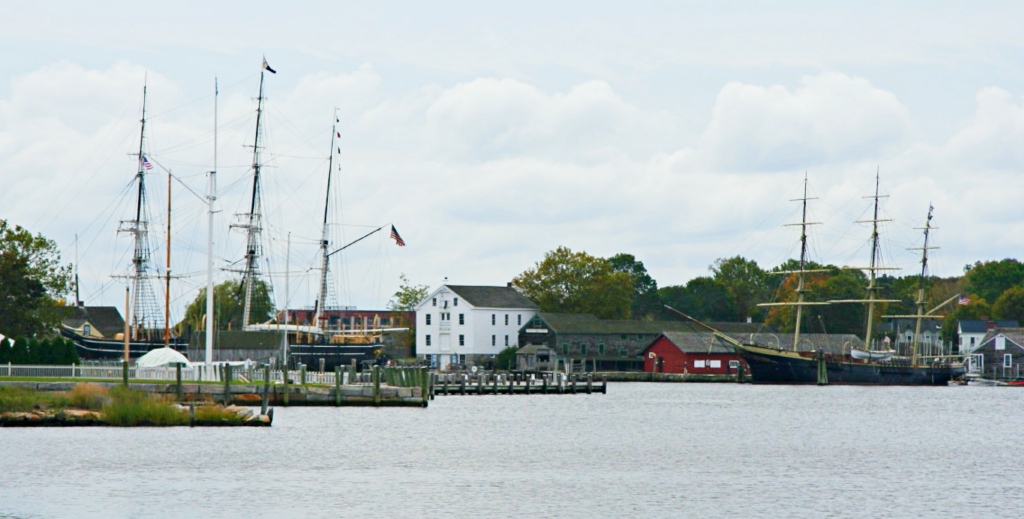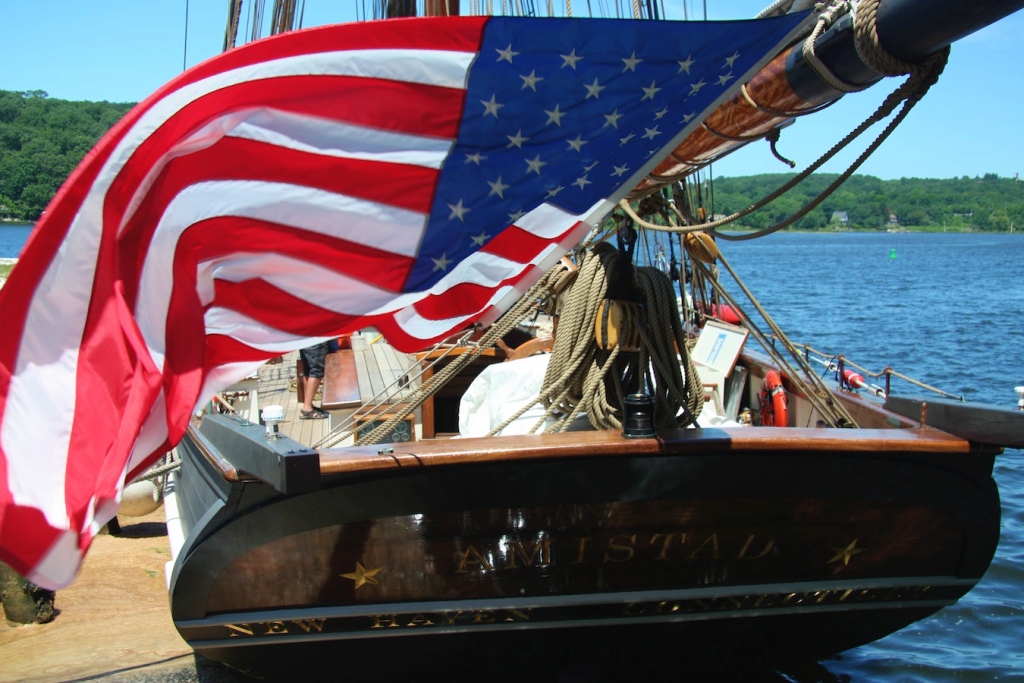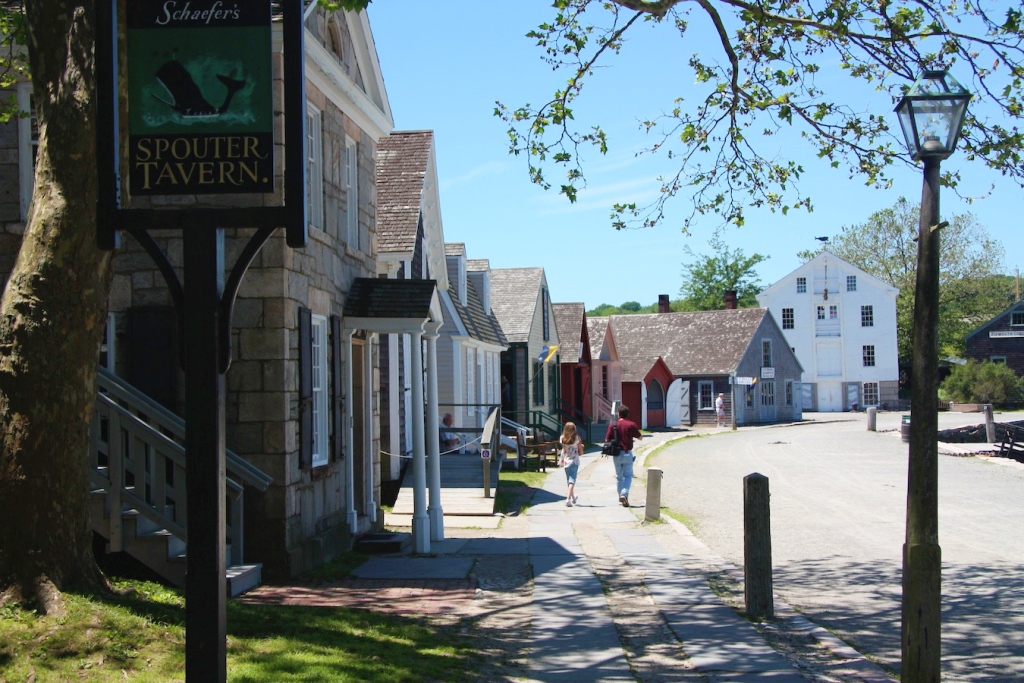Mystic CT Travel Guide
Connecticut's maritime life, past and present, comes alive at Mystic Seaport Museum, the Mystic Aquarium, and in the nearby seaside town of Stonington.
The town of Mystic, Connecticut, is quaint and pretty, with interesting shops, lots of restaurants, and a bascule bridge that will interest anyone who likes antique engineering.
A Bit of History
Mystic, Connecticut was an old New England seaport town. Mystic Seaport Museum began in 1929 as the Marine Historical Association, founded by three citizens of Mystic CT who were interested in preserving aspects and objects from the town's maritime past.
The site of the museum is the former shipyard of George Greenman and Company, which built wooden clipper ships in the 19th century (hence the name Greenmanville Avenue for the street that passes the shipyard.)
Plan Your Visit
There's a lot to see and do in Mystic. To get the most for your time and money, you need to plan your visit.
Three Hours to Two Days
Minimum time for a visit to Mystic Seaport Museum is three or four hours, but there's enough there to fill several days. In fact, your admission wristband for the Museum is valid for two days. You can leave the museum, visit the Mystic Aquarium and the town center, have a meal, and return to the Museum the next day.
Special Events, Performances & Cruises
The Museum stages numerous special events, performances, tours and cruises. Include the ones you like in your plan. I'd suggest that you plan and reserve your river cruise(s) first so you get on the ones you want; then schedule your other events. In between, walk around the re-created 19th-century village to visit the many permanent exhibits. In the heat of summer, you may wish to be in the air-conditioned exhibit galleries or the planetarium (where you get to sit down) when the day is hottest.
Reserve Lodgings in Advance!
You'll need a place to spend the night. In high summer, the capacity of hotels, motels, inns and guesthouses near Mystic is not sufficient to handle the crowds. Most lodgings are fully booked well in advance in July and August. When booking, guests may be required to prepay their entire stay.
Restaurants & Cafés
Mystic Seaport has its own restaurants, including the Seaman's Inne Restaurant & Pub, the Café & Bake Shoppe, and the Galley Restaurant.
If you'd rather shop around, you can walk to the center of the town of Mystic in about 10 or 12 minutes. A variety of restaurants and snack stands awaits you there.
Where to Stay
The huge Mystic Seaport Museum is big enough to handle the crowds, but the capacity of nearby hotels, motels and inns is not—the lodgings are fully booked in July and August, and guests may be required to prepay their entire stay.
Lodgings in Mystic proper are mostly hotels and motels, with a few guesthouses. In the nearby quiet village of Noank, a few miles south and east along Route 215 (map), there are some quiet inns.
Just Passing Through?
You can avoid the hotel crush by taking an Amtrak train through this area and getting off for the day at Mystic, where a bus will take you the mile from the station to Mystic Seaport.
After your day roaming around the ships, old buildings, and exhibits, board an afternoon train to Providence or Boston (or New Haven, or New York City). There's no extra charge for the stopover if you buy a through ticket, and you obviate the need for a room.
Hotel Map with Prices
Use this handy Hotel Map with Prices to find just the accommodation you'd like in or near Mystic:
Transportation
If you can go by train, it's easier! Read on.
By Car
Follow Interstate 95 to Exit 90, then drive south following the signs for Mystic Seaport. Here's a map.
The entrance to Mystic Seaport and the museum's main parking lot are less than a mile (1.6 km) south of I-95, but in summer—especially on weekends—two-lane Greenmanville Avenue may be choked with traffic, and it may take quite a while to cover that short distance.
Getting off I-95 at Exit 89 (west of Exit 90) may not be any better, as all traffic in the town of Mystic must cross the Mystic River on the two-lane bascule bridge. Traffic on Main Street in the town center is always heavy in summer, and when the bridge is raised to let boats pass beneath, the traffic stops completely.
By Train
Coming by Amtrak train from New York City, New Haven, Providence or Boston (or points along the way), you can arrive in Mystic, walk from the train station to Mystic Seaport (10 to 15 minutes), spend most of the day at the Seaport, spend some time in the town of Mystic, then catch an afternoon or evening train onward, or return. More...
What to See & Do
Mystic Seaport Museum is one of the top tourist attractions in New England, drawing large crowds every day of the summer.
The Mystic Aquarium features fascinating exhibits of marine life, and on the adventures of undersea explorer Robert Ballard, who led the team that discovered the wreck of the Titanic.
Mystic Seaport Museum
Mystic Seaport Museum is a great place to come with kids, as they can climb aboard real sailing vessels, take a boat ride on the Mystic River, clip-clop around town in a horse-drawn carriage, and talk to the interpreters who can explain what went on in a 19th-century New England seacoast town.
Although it is technically a nonprofit museum, there is much more life to it than just rows of glass cases housing exhibits. Most of your time will be taken walking through the village and watching the interpreters (staff) do their jobs and explain what they're doing.
To have the best possible time, plan your visit. It's easy, because you can leave the Mystic Seaport campus and return later, no problem.
Arrival & Parking
The entrance to Mystic Seaport and the museum's main parking lot are less than a mile (1.6 km) south of I-95, but in summer—especially on weekends—two-lane Greenmanville Avenue may be choked with traffic, and it may take quite a while to cover that short distance.
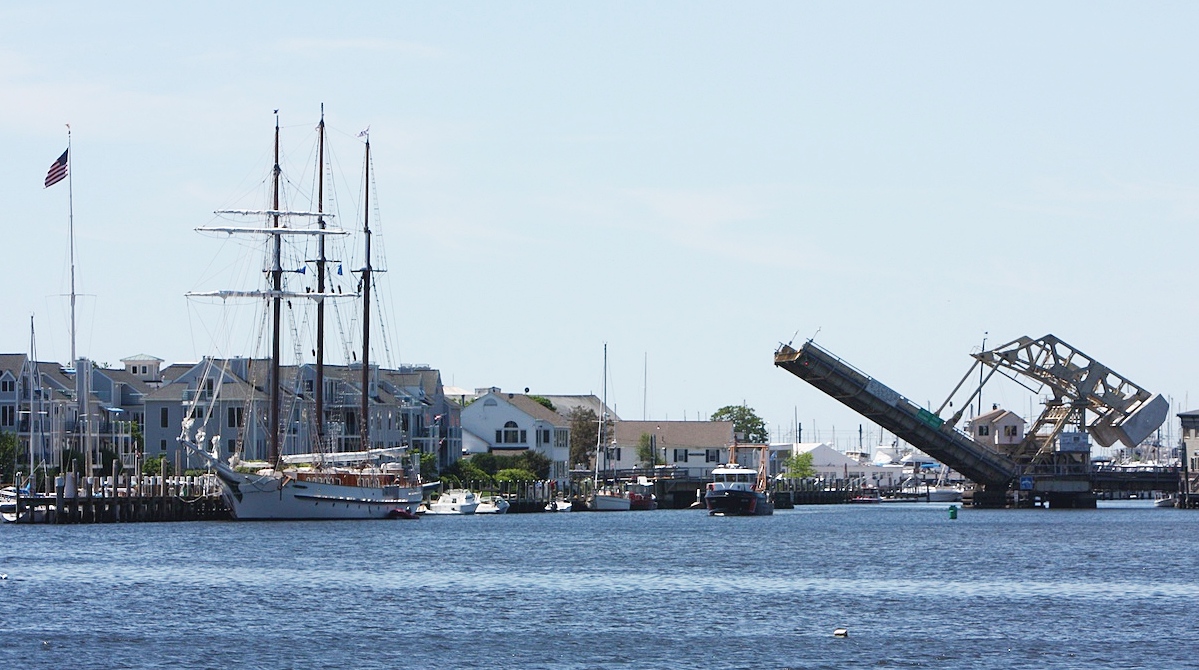
On the right, Mystic's notable bascule bridge.
All traffic in the town of Mystic must cross the Mystic River on the two-lane bascule bridge. Traffic on Main Street in the town center is always heavy in summer, and when the bridge is raised to let boats pass beneath, the traffic stops completely.
Old Mystic Village
The recreated 19th-century seaport village at Mystic Seaport.
Mystic Seaport is actually several museums in one. Most fascinating (after the tall ships) is its aspect as a restored or "re-imagined" 19th-century Connecticut shoreline village.
Historic buildings from various locations were brought here to the former Greenman Brothers' shipyard and positioned to resemble a living town. You really can get a sense of what it was like to walk through 19th-century Mystic here.
Mystic River Scale Model
Perhaps the best place to start is the 1/128th scale model of Mystic, with over 250 tiny buildings bringing to life the town and the Greenman Brothers' shipyard (site of Mystic Seaport) between 1850 and 1870.
You can see the clipper ship David Crockett under construction, and all the other details of life at that time. Look for the 50-foot scale model at the north end of the Village Green not far from the Visitor Center.
Shops Along Middle Wharf
Each of the shops facing Middle Wharf, next to the Charles W Morgan, has exhibits:
—The Shipsmith Shop is the only surviving 19th-century whalers' ironwork shop, where the tools and weapons of the whaling trade were made.
—The Nautical Instrument Shop holds the tools of navigation.
—The Hoop Shop and Shipcarver's Shop show how necessary goods were made from iron and wood.
—The Print Shop, Drug Store, Bank, Chapel, General Store and School House were fixtures of any busy 19th-century town.
Cruises on the Mystic River
Why be a landlubber when you can get out on the water and see the world from a mariner's point of view?
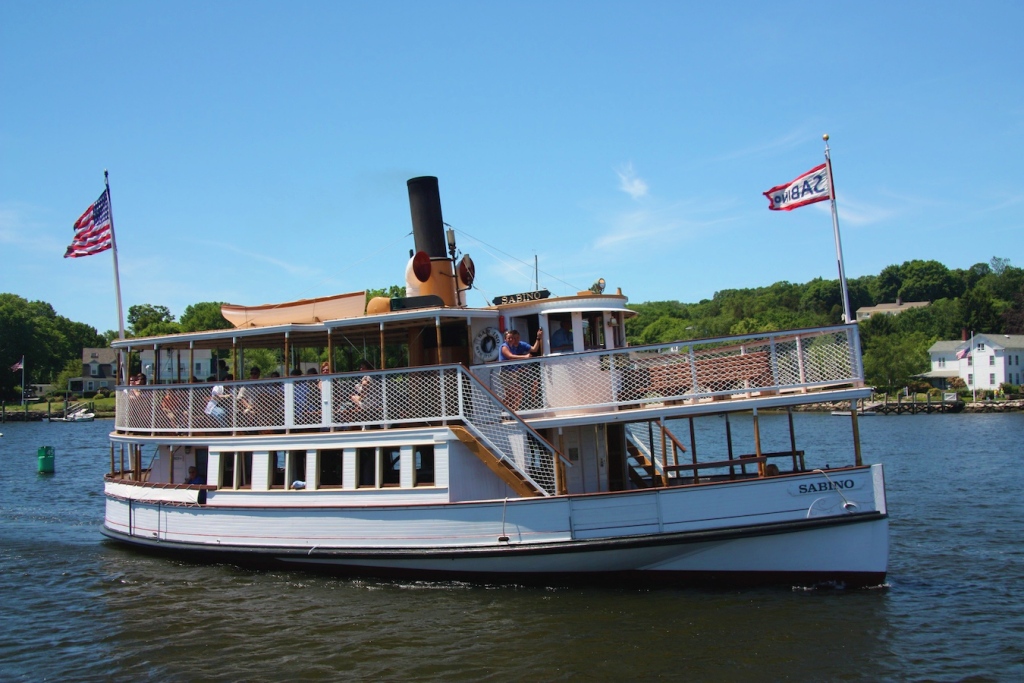
m/v Sabino heads out for a river cruise.
Mystic Seaport Museum has numerous ways that you can get out on the water, enjoy cooler air, and see the restored village and the Mystic River from a different viewpoint from mid-May through mid-October (Columbus Day).
Daytime cruises (10 am to 5 pm) are 30 minutes long. Late afternoon/evening cruises last 90 minutes.
All cruises require good weather, and are subject to a fee in addition to the museum admission fee.
Sabino
This little steamboat is perhaps the most beloved of Mystic Seaport's vessels, as it takes visitors on 30-minute daytime cruises up the Mystic River from mid-May through mid-October (Columbus Day). There's also a 90-minute late afternoon cruise down the river.
Resolute
This 26-foot, diesel-powered open launch takes passengers on 30-minute Mystic River cruises similar to those of the Sabino. Bring sunblock and drinking water.
Breck Marshall
This sleek 20-foot sailboat, a reproduction of a Crosby catboat, sets out on quiet, wind-powered 30-minute cruises when conditions are right, and offers a very different experience than the motor-driven Sabino and Resolute.
Small Boat Rentals
Want to do it yourself? Mystic Seaport Museum rents rowboats and small sailboats to visitors from its Boathouse.
Tall Ships
You can climb aboard most of these ships, and even take cruises on several of them.
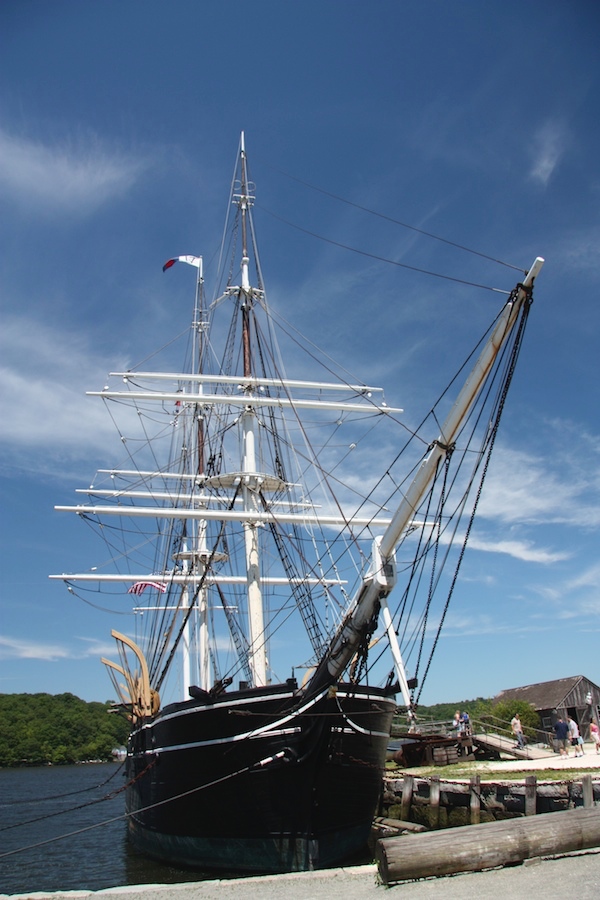
Whaling ship Charles W Morgan (1841).
Mystic Seaport Museum is noted for many excellent historical exhibits, but none more than their real boats and ships which include the last known whaling ship afloat, and a century-old coal-fired steamboat.
Charles W Morgan
The Charles W Morgan is the last wooden whaling ship in the United States still in the water. Launched from a shipyard in New Bedford, Massachusetts in 1841, she sailed continuously for 80 years. The last whaling ship of her kind (out of 2,700 which once plied the seas in the age of whale oil lamps), the Morgan has been fully restored (2014) and is again seaworthy—and sailing.
You can see other whaling ships and exhibits in the New Bedford Whaling Museum and Nantucket Whaling Museum, but only the Morgan is still afloat.
Whaleboat Exhibit
You'll explore the whaleship Charles W Morgan, but right on the same wharf, and even more fascinating in its way, is the much smaller whaleboat. The ship took whalers to the hunting grounds, but it was from this small boat that the men actually harpooned the whales. Only by seeing such a small boat and its simple equipment can you appreciate the courage and audacity of these maritime hunters.
L A Dunton
The fishing schooner L A Dunton (1921) recalls the great age of the New England fishing fleet.
Joseph Conrad
The full-rigged training ship Joseph Conrad (1882) is yours to explore, and imagine what life was like at sea.
Benjamin F Packard Cabin
The cabin of this ship built in 1883 is typical of the accommodations aboard a "Down Easter" or "Cape Horner," the large late 19th-century ships that sailed in record time around the Cape Horn, connecting the east and west coasts of the United States in the era before the railroads.
North Boat Shed
Changing exhibits of real boats—anything that floats and was used for transport on the sea.
Museums & Exhibits
The entire Mystic Seaport "village" is an exhibit, and each of its buildings contains excellent displays that are both fun and educational. But in addition to the restored village there are modern museum-style buildings with exhibits and displays that educate us about America's history with the sea.
Walking around the grounds of Mystic Seaport Museum in fine weather is the first thing every visitor wants to do, but fine weather or foul, there are lots of interesting indoor exhibits to learn from and enjoy no matter what the weather.
Besides the topical exhibits in the recreated Old Mystic Village, there are museum-style exhibits in more modern buildings on the north side of the Mystic Seaport campus.
More Whaling Museums
Fascinated by whales? Visit the New Bedford Whaling Museum and Nantucket Whaling Museum.
Mystic Aquarium
The Mystic Aquarium at 55 Coogan Boulevard (map) offers dozens of live marine exhibits and over 6000 sea creatures in the main aquarium, and exhibits chronicling the explorations of deep-sea adventurer Robert Ballard, who led the team that found the wreck of the Titanic.
An outdoor exhibit area called Seal Island lets you watch five species of seals and sea lions (including endangered Steller sea lions that can weigh up to 1700 pounds/771 kg!) sport and play in re-creations of their natural habitat.
There's a colony of 30 African penguins, and three beluga whales, as well.
Downtown Mystic
The center of Mystic, a half-mile (800 meters) south of Mystic Seaport, (map) is a delightful, historic Connecticut Shoreline town with lots of nice old houses, shops, restaurants, and the historic bascule bridge.
